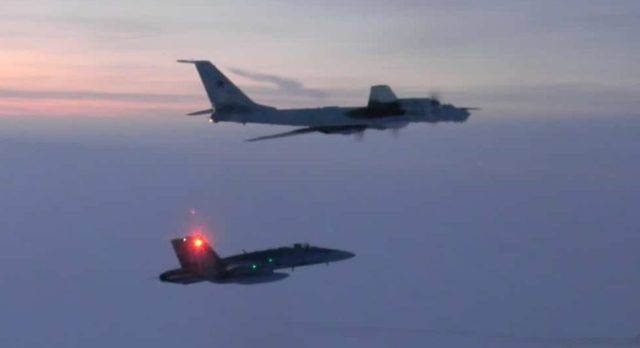
Let us retire 50-year-old radar planes, Air Force asks Congress NORAD F-22s, CF-18s, supported by KC-135 Stratotanker and E-3 Sentry AWACS aircraft, intercepted two Russian Tu-142 maritime reconnaissance aircraft entering the Alaskan Air Defense Identification Zone on Monday, March 9th. (NORAD photo/Released)
The U.S. Air Force’s new budget request includes nearly a quarter-billion dollars to start replacing decades-old E-3 AWACS radar planes with…well, it’s not quite decided. But the “leading candidate” is the E-7 Wedgetail, a Boeing aircraft flown by several allies.
“We’re going to be making that decision [of which aircraft to buy] sometime, I think, within the next several months,” Air Force Secretary Frank Kendall said Friday during a roundtable with reporters before the Pentagon’s budget request was sent to Congress on Monday. “We’ve got to take a look at requirements and do some market research…The leading candidate, quite obviously, is the E-7, but we want to do our due diligence.”
The Air Force asked lawmakers for permission to retire 15 E-3s, nearly half of its fleet. Replacing the E-3s will also require Congressional approval. In their 2023 budget request, Air Force officials are asking for $227 million to start retiring and replacing the Sentry, more commonly known as the airborne warning and control system, or AWACS, and easily recognized by the giant dorsal disc of its radar antenna. The Air Force began flying the E-3 in the 1970s, but it is based on the Boeing 707 airliner, a plane that first flew in the 1950s. Gen. Mark Kelly, the head of the Air Combat Command, recently quipped that the plane has difficulty flying “1/8 of a mile away from a [maintenance] depo—and that’s with the finest sustainment enterprise on the planet.” Still, the U.S. and its NATO allies have been flying E-3s AWACS regularly to monitor the airspace in Europe since Russian forces invaded Ukraine in late February.
The plane that might replace it, the Wedgetail, is based on a Boeing 737-200 airliner, It carries a roof-mounted active scanned array radar that can track aircraft, ships and ground vehicles, according to Northrop Grumman, which makes the radar. Boeing developed the E-7 in the late 1990s and early 2000s for the Royal Australian Air Force. Turkey and South Korea now fly E-7 variants as well, and the U.K. Royal Air Force has ordered five aircraft.
Top Air Force brass haven’t been shy about their desire to buy the Wedgetail. In February 2021, Gen. Kenneth Wilsbach, head of Pacific Air Forces, explicitly called for buying the E-7 to replace the E-3. But his boss, Gen. Charles “CQ” Brown, the Air Force chief of staff, said he wanted to explore other options before committing to the Wedgetail. In September, Kendall said the plane “could be useful to the Air Force.”
In October 2021, the AIr Force gave Boeing a contract to determine how Boeing might need to reconfigure the international version of the E-7 to meet its standards. The Air Force said it needed the study data to “evaluate potential E-7A acquisition strategies,” according to a contracting notice. Then in November, a Boeing executive told reporters at the Dubai Air Show that he believed the Air Force would announce E-7 buys in 2022.
Speaking at a Mitchell Institute event earlier this month, Wilsbach said the four E-3s under his command are often grounded for maintenance. He listed the E-7 and a few other unrelated weapons as being “in the category of things that I would want.” And he said the Air Force needs to buy them quickly.
“You’ve got to acquire those assets very quickly—maybe even to the max extent that industry can produce them,” he said. “But we’ve got to get them quickly and not waste time on a slow-buy schedule.”
In October, Kelly’s official Twitter account posted pictures of the general inside an E-7 demonstrator at his command’s headquarters in Virginia.
Speaking at the McAleese and Associates defense programs conference on March 9, the general included a photo of an Australian E-7 flying with a U.S. F-22 fighter jet. He said there’s “a lot of advocacy, a lot of effort into making sure we have a minimum of a fourth-gen sensor, if not going to a fifth-gen sensor,” for getting a new air surveillance radar plane.
“We will not win the air superiority battle if we cede the airborne domain awareness piece,” Kelly said.
The Wedgetail is built on the Renton, Washington, production line that makes the Navy’s P-8 sub-hunting patrol planes, though the roof-mounted radar and other military gear is installed elsewhere. The Royal Air Force E-7s, for example, are being converted at STS Aviation in Birmingham, England, a Boeing spokesman said.
“If the USAF were to choose E-7, we will work with the USAF to determine the best modification site,” the spokesman said.
___
© 2022 Government Executive Media Group LLC
Distributed by Tribune Content Agency, LLC




